|
|
Post by Radialicious on May 26, 2015 22:21:27 GMT 12
That big Mercedes must be a delightful obstruction to forward vision. I imagine the exposed valve gear would be lovely to watch in action.
|
|
|
|
Post by kiwithrottlejockey on May 27, 2015 8:39:34 GMT 12
That big Mercedes must be a delightful obstruction to forward vision. I imagine the exposed valve gear would be lovely to watch in action. See THIS THREAD to view a couple of video clips of the exposed valve gear in action. |
|
|
|
Post by Peter Lewis on May 27, 2015 9:11:00 GMT 12
Having checked through the WW1 Axis aircraft at the show, we'll now look at the Allied side. The Pfeifer Sopwith Scout ZK-SPH is a replica Sopwith Pup built way back in 1961 by Joe Pfeifer in California. Although initially airworthy and registered there as N54T, it had not flown for some decades. Imported into NZ some years ago, it went through a major refurbishment at Omaka and has now been painted up to represent Pup A6192 as flown by NZer Malcolm 'Mac' McGregor and carries the name 'Peggy' which refers to his sister. Although to flew again after its restoration on 27th March 2012, this was the first time I had seen it in the air. 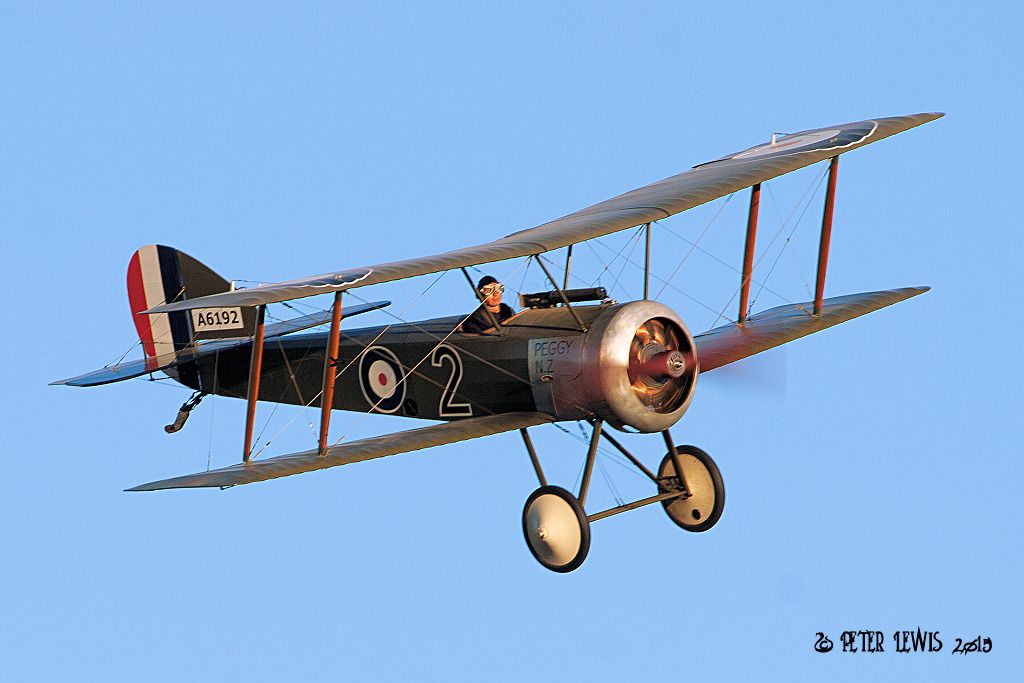 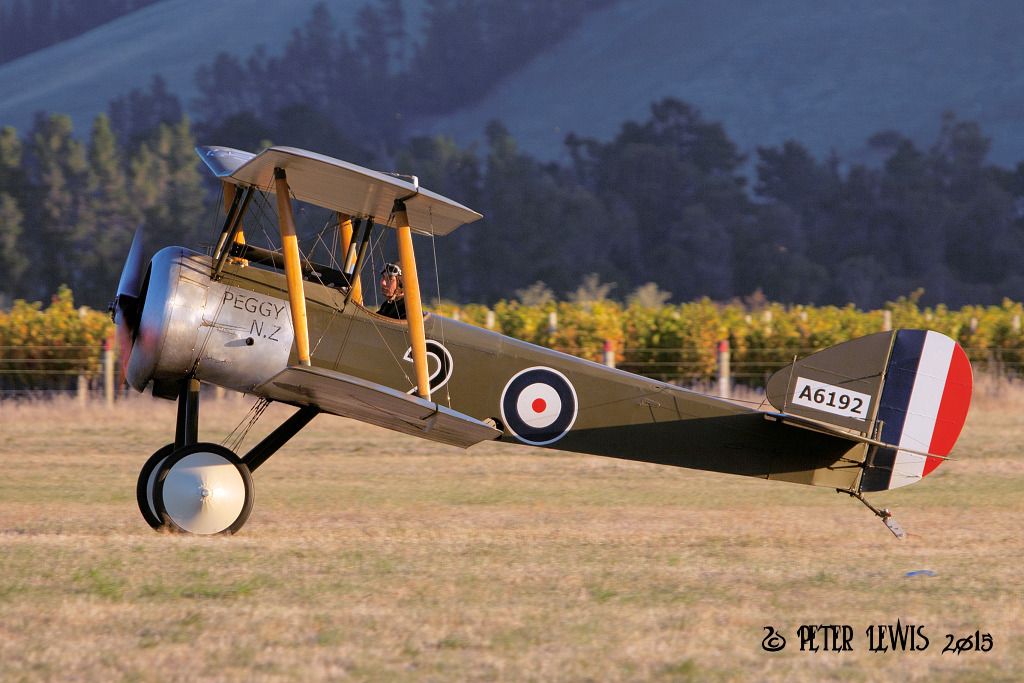 |
|
|
|
Post by Peter Lewis on May 27, 2015 17:33:06 GMT 12
The WW1 Italian aviation effort was represented by the Addems-Pfeifer Nieuport XI ZK-NIM. Built in Porterville, California, by Walt Addems and Joe Pfeifer, this aircraft intially flew as N148J and is powered by a 80 hp LeRhone rotary. Registered to The Vintage Aviator Ltd., Wellington, in March 2007 it appears as N2123 representing an Italian built Nieuport Bebe. The orignal N2123 was manufacured in 1917 under license from Nieuport by Maachi and was assigned to 80a Squadriglia italian Air Service in May of that year. That aircraft became the personal mount of Sgt. Alvaro Leonardi who survived the war with 8 victories. 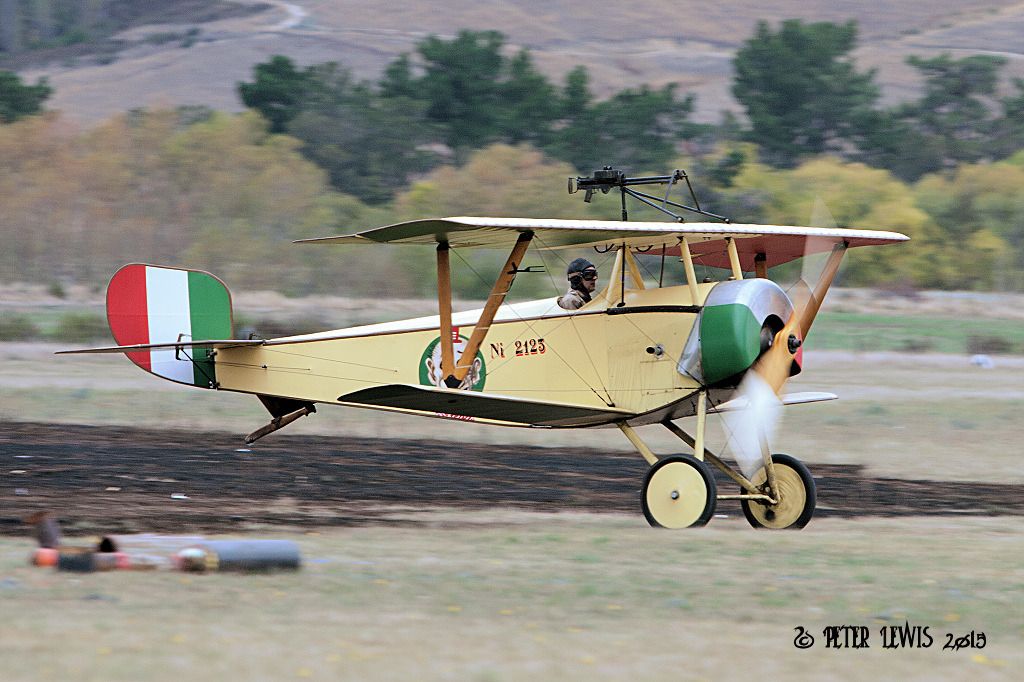 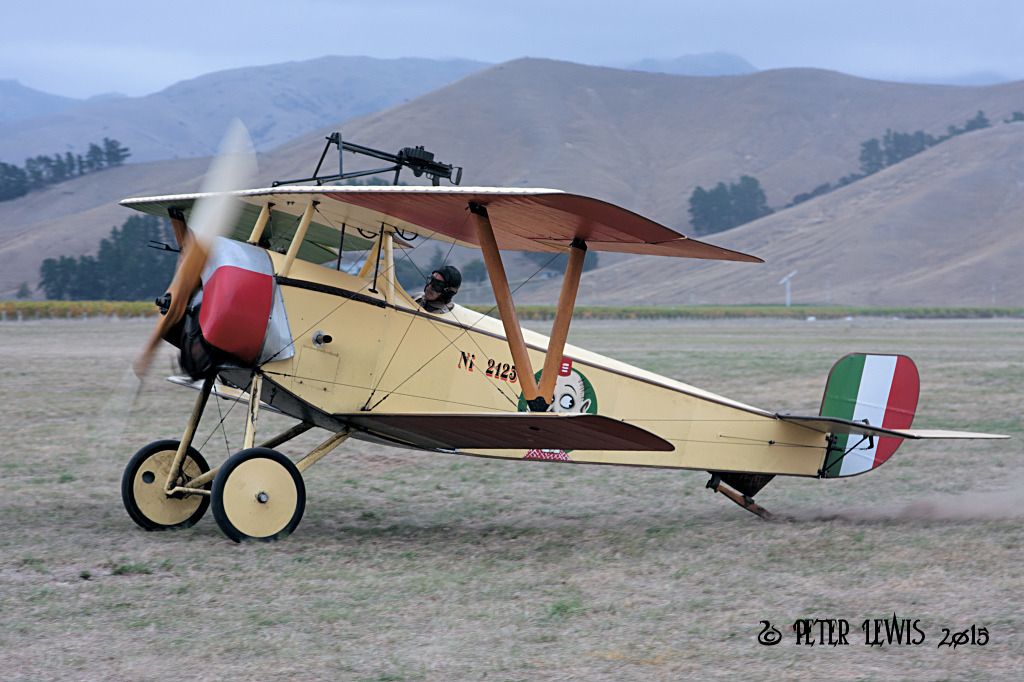 |
|
|
|
Post by Peter Lewis on May 28, 2015 8:53:23 GMT 12
The Classic Aircraft Nieuport N11 ZK-NII has been a regular airshow participant since it first flight at Omaka on 8th December 2011. The colours are said to represent the American Escadrille de Lafayette participation in the French Air Service, and have undergone some minor changes over its flying life. 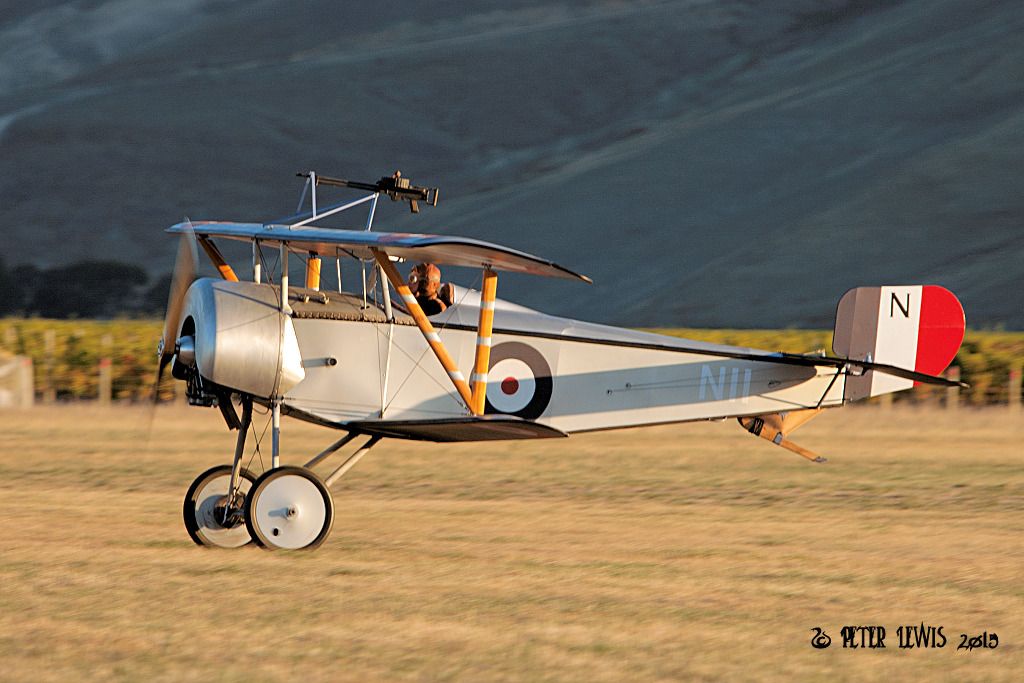 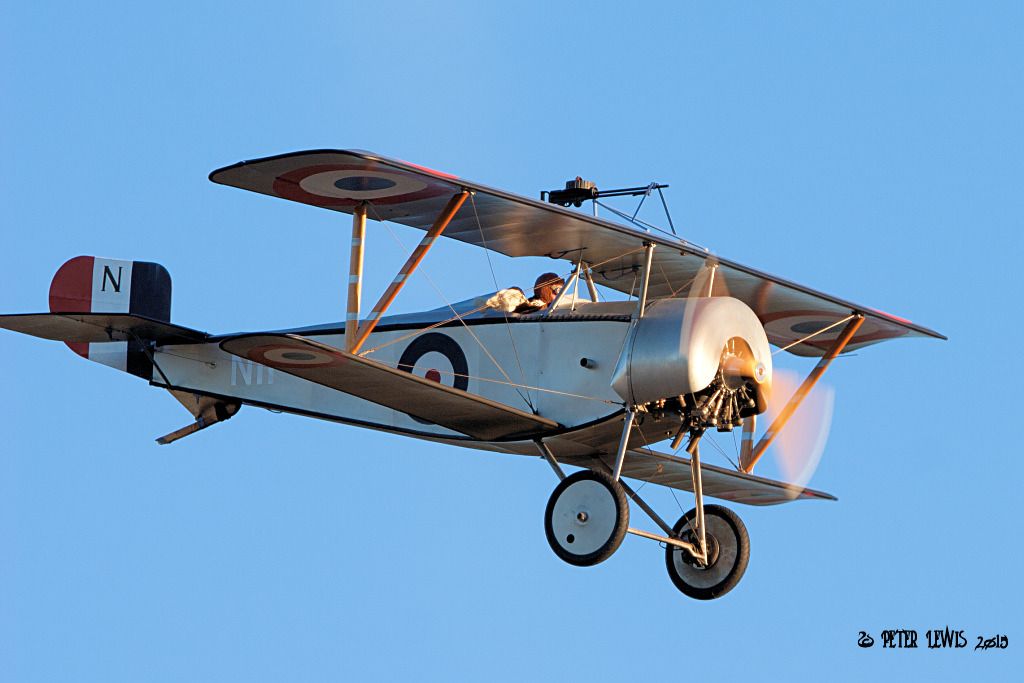 |
|
|
|
Post by DragonflyDH90 on May 28, 2015 12:06:54 GMT 12
A little info on NII Peter.
Not the American Escadrille de Lafayette any more, if I recall correctly the scheme represents that of Major Roderic Dallas RNAS. He was an Australian Ace with apparently the second highest number of downed aircraft by Australians (Robert Little was higher).
The RNAS Nieuports were delivered straight from the French, therefore no fuselage roundel, as this was not French practice at that time. The British added roundels but not as per the French colours whilst leaving the French roundels on the wings.
It will be interesting to see if anyone on the overseas forums picks up on this..
|
|
|
|
Post by ErrolC on May 28, 2015 12:37:59 GMT 12
|
|
|
|
Post by Peter Lewis on May 28, 2015 17:27:22 GMT 12
Thanks fot the update Ryan.
Info on ZK-NII seems to be pretty sparse.
Yet the Classic Fighters Omaka 2015 printed progam talks of the aircraft still being 'adorned with the Indian Head motif ' (page 14).
Obviously nobody went outside and took a look!
|
|
|
|
Post by Peter Lewis on May 28, 2015 17:55:24 GMT 12
Among the lists of odd WW1 aircraft appears the de Havilland DH5. Backward stagger of the wings is never going to be a popular look unless you are a Beech 17 enthusiast. Unsurprisingly then, there is only one airworthy DH5 replica around. This aircraft was built up in the United States by John Shiveley and registered to the Florida Charter Company as N950JS in November 1992. Ownership then passed to the Ryders Replica Fighter Museum located at Guntersville, Alabama until the registration was cancelled ten years later. Registered as ZK-JOQ to Omaka Collection, Wellington in September 2004 and transferred to The Vintage Aviator Ltd., Wellington in September 2007, the DH5 appears as A9242 of 2 Squadron AFC (alias 68 Squadron RFC) as operated in France. 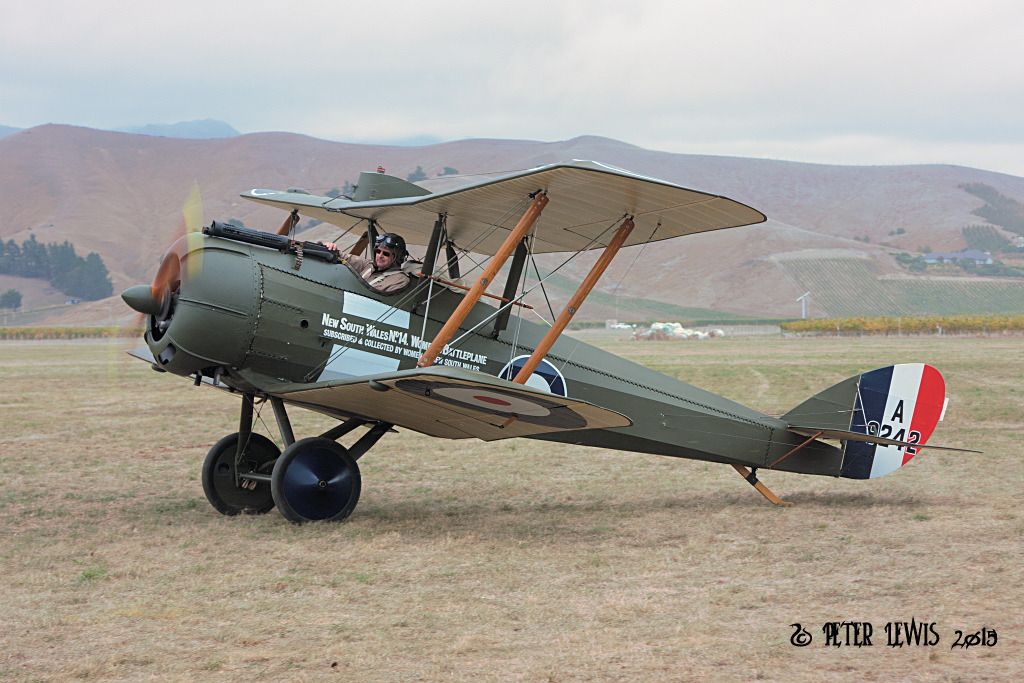 |
|
|
|
Post by ErrolC on May 28, 2015 19:10:18 GMT 12
A little info on NII Peter. Not the American Escadrille de Lafayette any more, if I recall correctly the scheme represents that of Major Roderic Dallas RNAS. He was an Australian Ace with apparently the second highest number of downed aircraft by Australians (Robert Little was higher). The RNAS Nieuports were delivered straight from the French, therefore no fuselage roundel, as this was not French practice at that time. The British added roundels but not as per the French colours whilst leaving the French roundels on the wings. It will be interesting to see if anyone on the overseas forums picks up on this.. ZK-NII was planned to fly at the 2013 show 'The Yanks are Coming', but engine issues prevented it. I managed to capture it being taken out for engine runs on Wednesday 27th March. 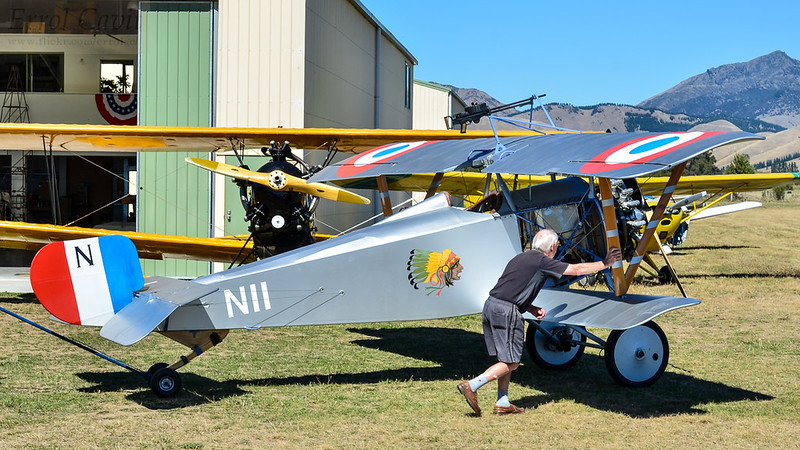 ZK-NII with fresh Lafayette markings ZK-NII with fresh Lafayette markings by Errol Cavit, on Flickr The photo of it in the 2013 programme shows it with red stars on white roundels and tail. |
|
|
|
Post by Peter Lewis on May 29, 2015 8:44:32 GMT 12
Always a star performer, the Gerald Thornhill TS 1 Sopwith Camel Replica ZK-JMU was built in the USA by Gerry Thornhill and Carl Swanson. The aircraft does utilise a number of original components such as the wicker seat and instruments, and is powered by by a 160hp Gnome Monosoupape rotary engine. Originally registered to Gerald Thornhill, Hampshire, Illinois on 21st May 1985 as N4463, at that time it wore American service colours. The US registration was cancelled in November 1998 as 'exported'. Appearing as ZK-JMU in March 2001 registered to P R Jackson, Wellington, the Camel now sports the livery of B3889. The original B3889 was one of the 70 Squadron RFC aircraft used by Blenheim born Capt Clive Collett.  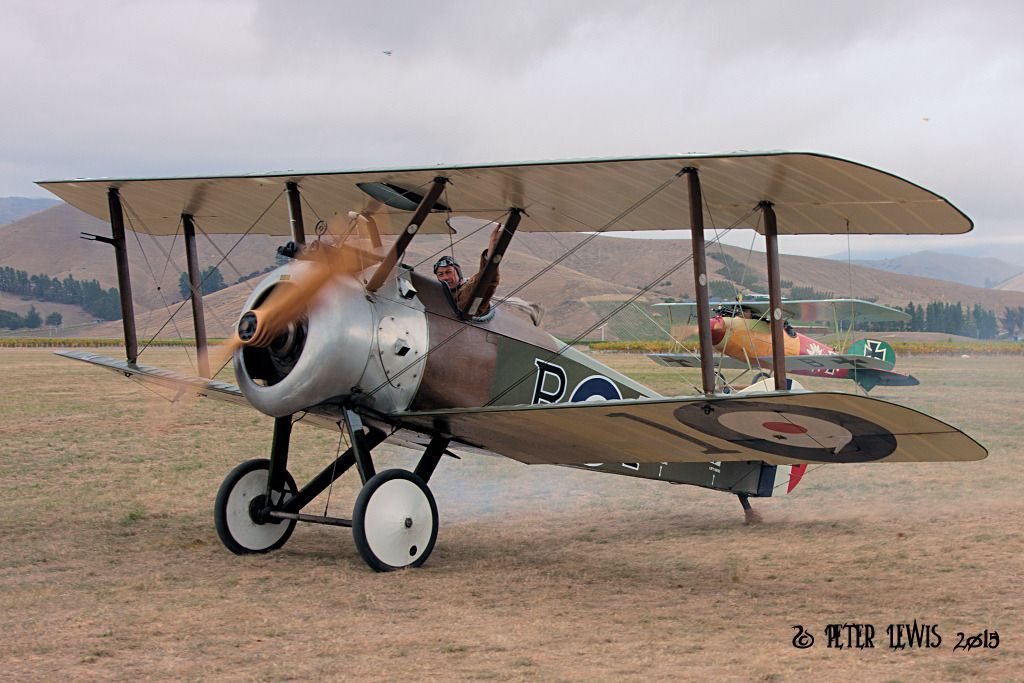 |
|
|
|
Post by errolmartyn on May 29, 2015 9:37:22 GMT 12
Always a star performer, the Gerald Thornhill TS 1 Sopwith Camel Replica ZK-JMU was built in the USA by Gerry Thornhill and Carl Swanson. The aircraft does utilise a number of original components such as the wicker seat and instruments, and is powered by by a 160hp Gnome Monosoupape rotary engine. Originally registered to Gerald Thornhill, Hampshire, Illinois on 21st May 1985 as N4463, at that time it wore American service colours. The US registration was cancelled in November 1998 as 'exported'. Appearing as ZK-JMU in March 2001 registered to P R Jackson, Wellington, the Camel now sports the livery of B3889. The original B3889 was one of the 70 Squadron RFC aircraft used by Blenheim born Capt Clive Collett.   For those who would like to know more about Clive Collett, who deserves to be better known today, here is my bio entry on him from Vol Three of my For Your Tomorrow: COLLETT, Captain Clive Franklyn, MC*. 540 (prev No.?); b Spring Creek 28 Aug 86; Queen's Coll, Tauranga; electrical engineer - Turnbull & Jones Ltd, [at?]. NZ Army/TF Tauranga MR 2yrs, Emb Limerick & worked passage to UK 16 Oct 14, arr 23 Dec 14, London & Provincial Flying Sch as Pilot u/t by 4 Jan 15, RAeC Cert 29 Jan 15; RFC Brooklands/2RAS as Pilot u/t 17 Feb 15, Comm 25 Mar 15, Pilots Badge & 11 Sqn (various a/c types) 25 May 15, inj in a/c acc at Hendon 6 Jul 15, 8 Res Sqn (various a/c types) 30 Jul 15, 32 Sqn (various a/c types) 1 Mar 16, emb for France & 18 Sqn (various a/c types) 9 Mar 16, hosp 19 Apr 16 [result of 'a serious flying accident while flying a machine home to England' on 18th? sick leave until 9 Jun], Experimental Armament Sqn at Orfordness as Flt Cdr 'A' Flt (various a/c types) 1 Aug 16, made the 1st parachute descent from a British military aeroplane 13 Jan 17 [and a 2nd descent 21st], ['A' Flt moved to Martlesham Heath in Jan 17 (also Collett?)], 59 Res Sqn (various a/c types) as instr c.17 Apr 17, 43 Res Sqn [redesignated 43 Trg Sqn 31.5.17] (various a/c types) as instr c.28 Apr 17, CFS 4 Jun 17, 'crashed landing' (uninj?) 23 Jun 17 [next flew on 2 Jul], to France & 70 Sqn (Camel) 24 Jul 17, wdd in hand in combat & to hosp 9 Sep 17, emb for UK & hosp [sick leave until c.1 Oct], Armament Experimental Stn at Orfordness 12 Oct 17, Aeroplane Experimental Stn at Martlesham Heath [until 8 Nov 17], 73 Trg Sqn as instr (various a/c types) [4 Dec?] 17, kaa 23 Dec 17 (Albatros). Edinburgh (Comely Bank) Cemetery - K.903, Midloth., Scotland. Son of Horace Edwin & Alice Marguerite Collett (née Radford), Tauranga. Note: credited with 7 e/a dest, 3 out of control & 1 shared out of control. Also awarded the War Medal of the Aero Club of America.Some amendments to the above (published in 2008) have since come to light and will appear in my next work (still a few years away from completion, however) - Ack Emmas to Zeppelin Hunters – New Zealand airmen and airwomen in the Great War and Russia, 1914-1919.Errol |
|
|
|
Post by Peter Lewis on May 30, 2015 9:37:26 GMT 12
The Nieuport replica marked as N4187 of the Imperial Russian Air Service was on static display throughout the event. Apparently, when construction of this Nieuport replica began in Oregon in the 1970s, it was intended that it would be completed as a 7/8 scale Nieuport 15. However, the owner was unable to complete the project due to his failing eyesight. The project has now been relisted as variously a Nieuport 16, 17 or 23. No doubt time will tell. Owned by an Omaka-based syndicate. The ordnance on the wing would be mockups of Le Prieur rockets. The Le Prieur rocket was essentially a cardboard tube filled with 200 grammes of black powder with a wooden conical head attached. Intended for air-to-air attacks on observation balloons and airships. According to a Russian website, "Plane with a mermaid, it Nieuport 17, the French production №4187, 22th KAO. Pilots (Podporuchik rus) Lieutenant V.M.Pokrovsky (August 1917) and (starshiy unteroficer rus) senior noncommissioned officer G.I.Kibasov (November 1917)." 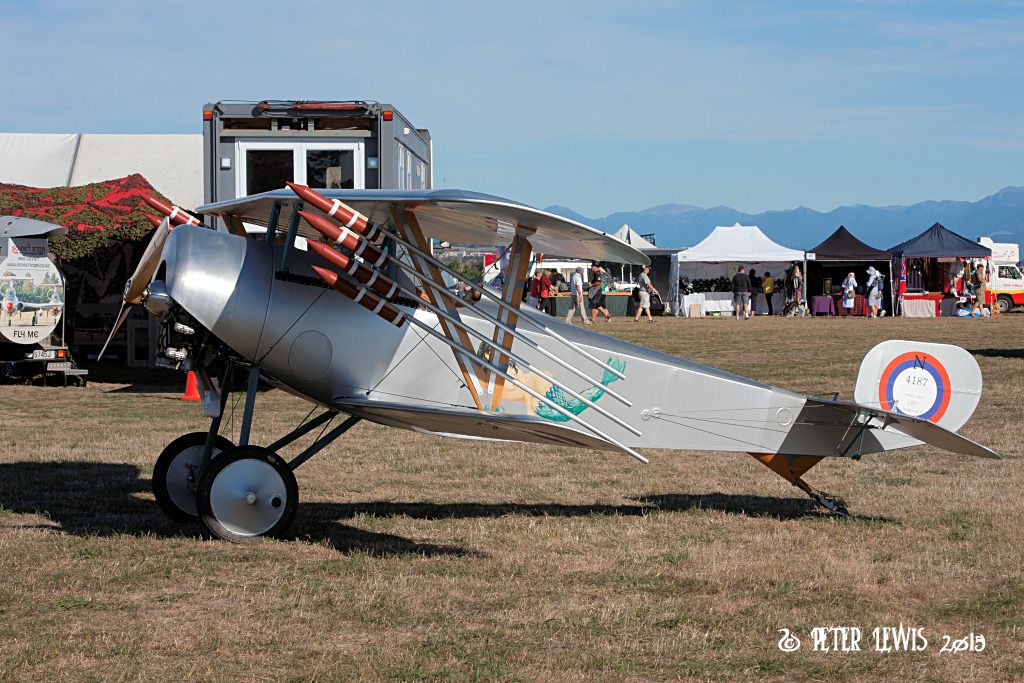 |
|
|
|
Post by Peter Lewis on May 30, 2015 21:32:40 GMT 12
One of the centrepiece events of the show was 'The Pioneer Renaissance Race'. This was a supposedly competitive event between a number of Penny Farthing cycles, vintage cars, and pre-1914 aircraft. The three aircraft were two Bleriots and the Pither. The first Bleriot was the Airdrome Aeroplanes Bleriot XI ZK-BXI built by Gert van Kruiningen based at Rangiora. This replica is not wooden framed as was the original, but constructed from aluminium tubes riveted and painted to make it look authentic. This replica kitset is produced by Airdrome Aeroplanes a small company in Holden, Missouri in the US. Power is by a 1928 Velie M5 five cylinder radial engine. The aircraft had not yet flown prior to the show and unfortunatly, despite appearing at the start line, engine problems prevented it from taking part in the race. The aircraft certainly looks the part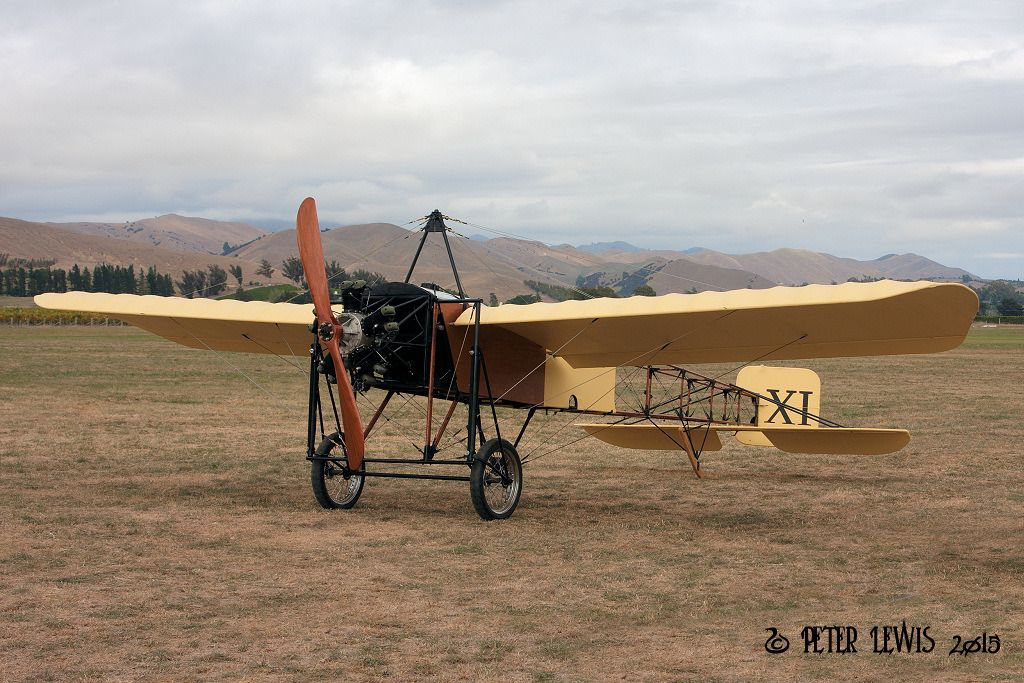 A mildly annoyed pilot departs the Bleriot after the engine refused to perform A mildly annoyed pilot departs the Bleriot after the engine refused to perform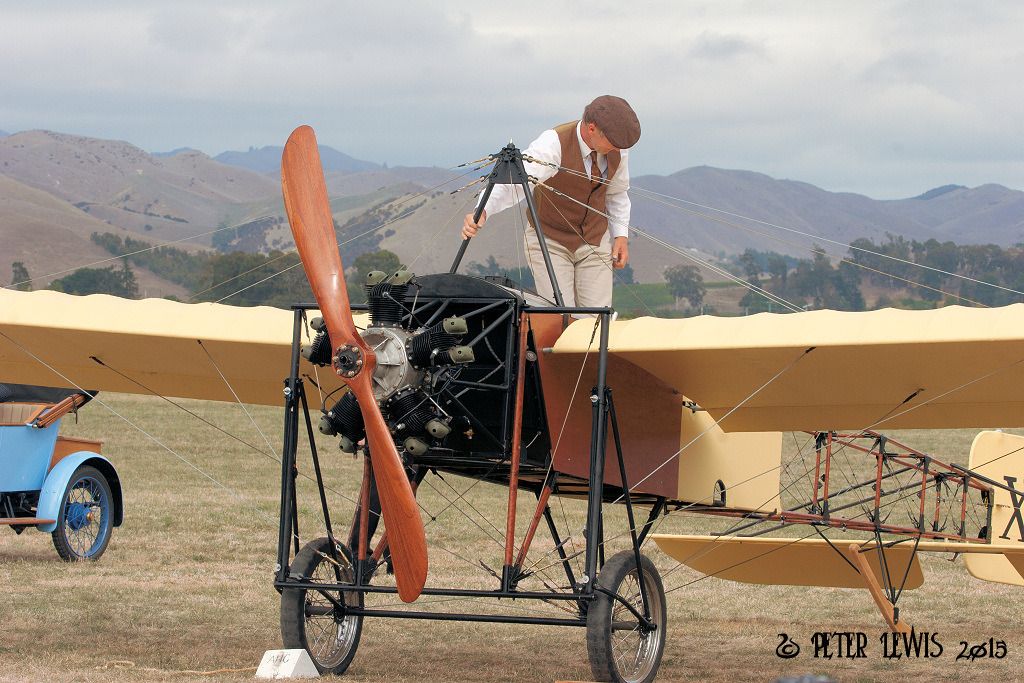 |
|
|
|
Post by Peter Lewis on May 31, 2015 9:04:49 GMT 12
The second Bleriot carried the tail insignia XI-2. This was intended to be a bit of a joke machine. Constructed locally and 'powered' by an electric motor, it was the comic relief of the show. It did move (with some of manpower assistance), and a bit later the fuselage collapsed and the pilot was carried away by medical orderlies dressed in approprite period costumes. 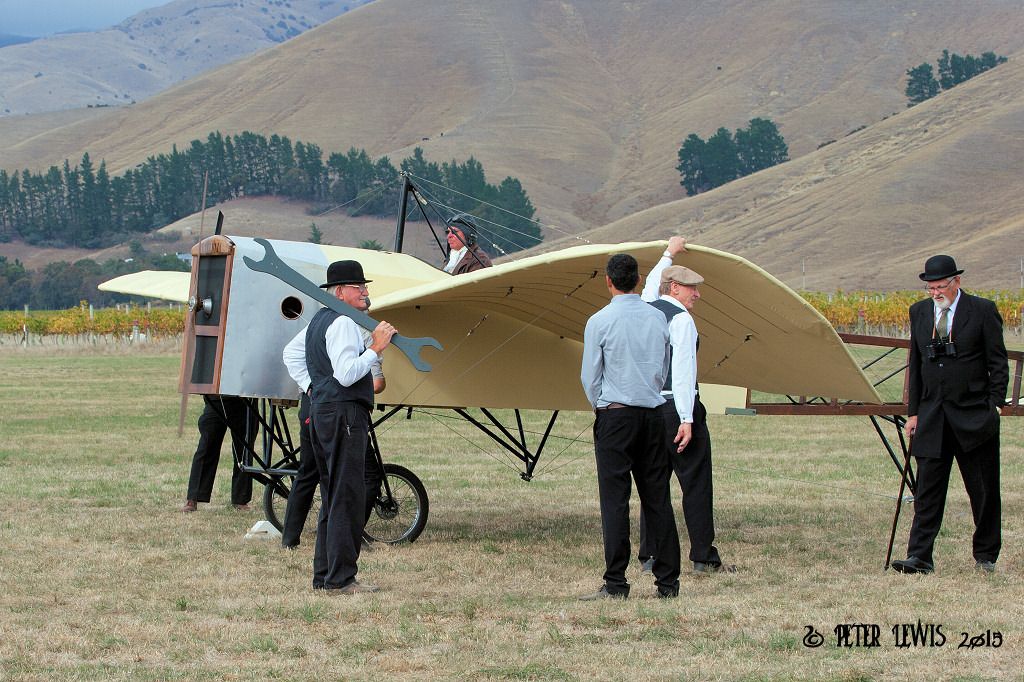 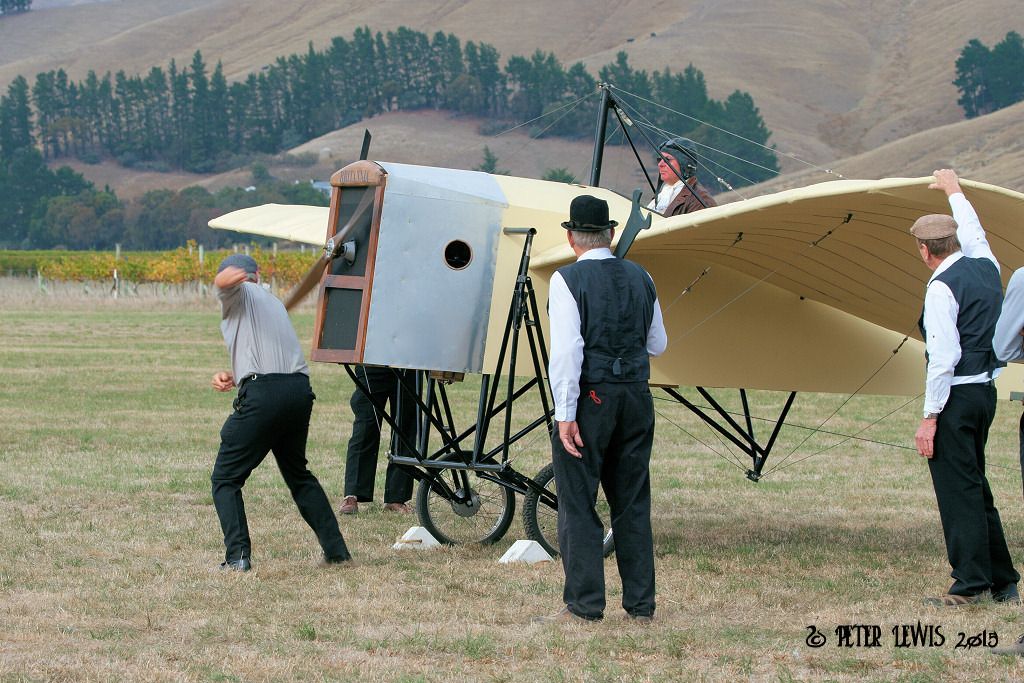 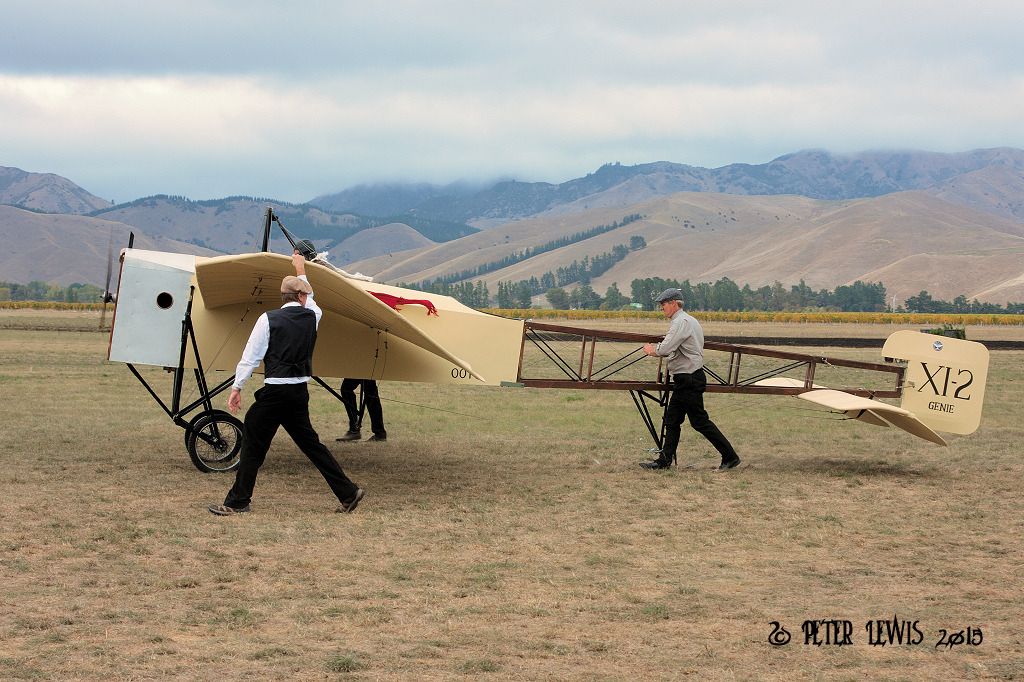 |
|
|
|
Post by Peter Lewis on May 31, 2015 19:10:35 GMT 12
The third aircraft involved in this competition was the Pither Monoplane Replica. Bert Pither in association with Simon McDonald built an aircraft to their own design in Invercargill in 1909-1910. On completetion the machine was taken to Oreti Beach and tested in July 1910. Reports that the aircraft actually flew are unverified, if this did occur then he flew prior to the Walsh Brothers verified February 1911 flight in Auckland. Colin Smith's Croydon Aircraft Company has built a replica of Pither's aircraft to put the 1910 design to a practical test. Working drawings were able to be produced from usefully detailed contemporary newspaper reports and photographs, although no one knows what adjustments Pither later made at his beach test-site. A replica Pither V4 engine has also been maufactured and fitted. This replica made several successful straight line hops at the Mandeville airfield on 18 February 2004. For its appearance at Omaka the aircraft was registered as ZK-JAH to Croydon Aircraft Co.Ltd., Gore on 13th January 2015. The Pither was able to taxii under its own power for the competition, and then continued on to make a straight run down RW30 where it was able to lift the tailwheel off, though the main wheels appeared to maintain ground contact. 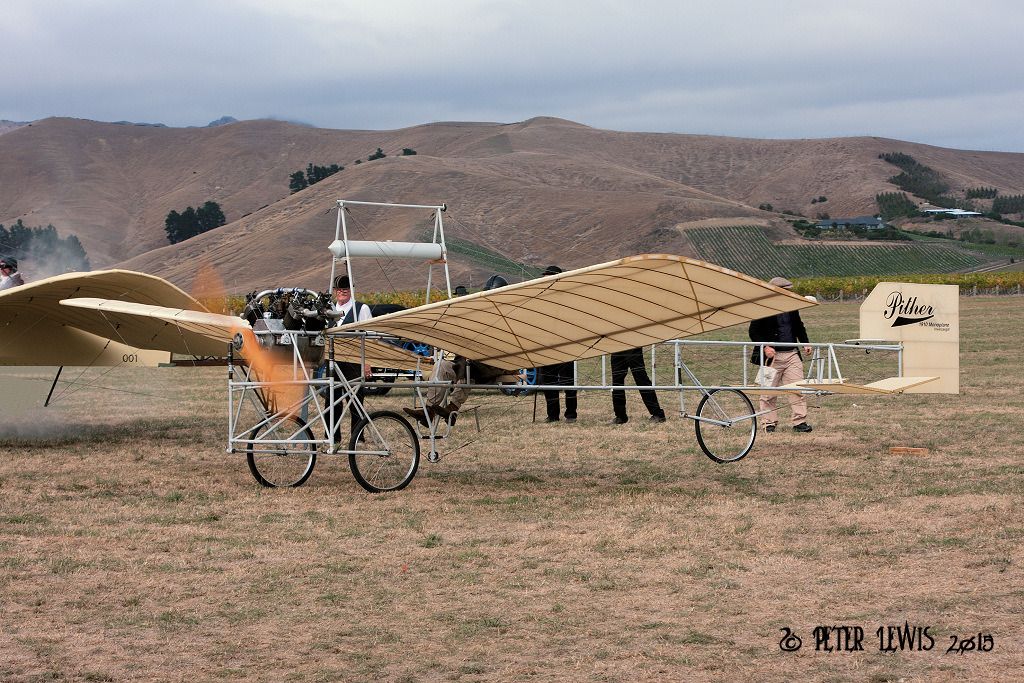 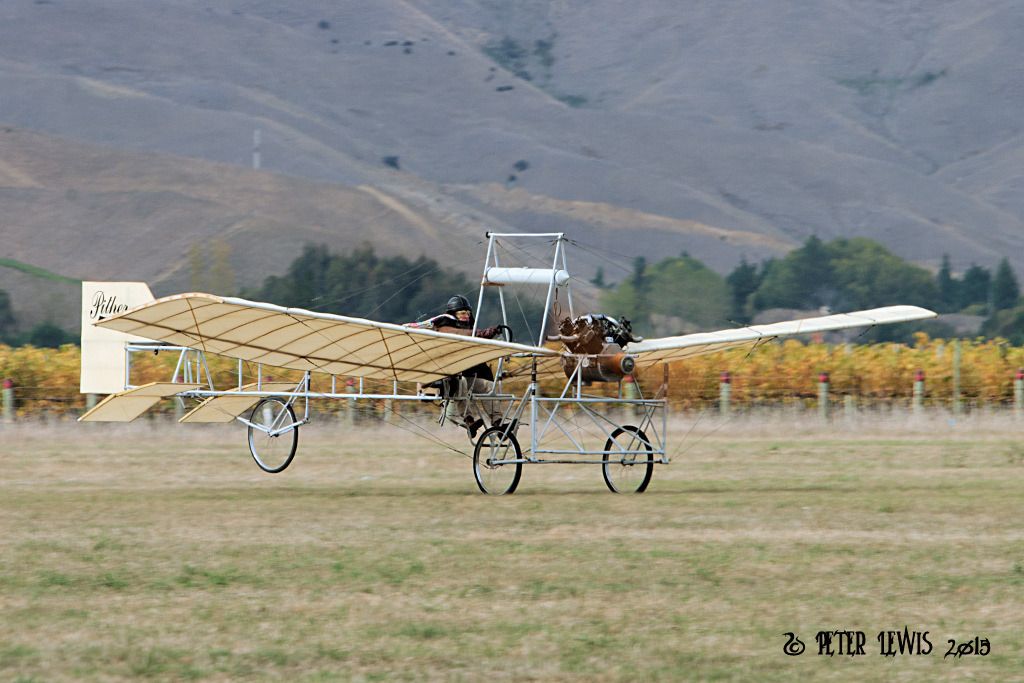 |
|
|
|
Post by errolmartyn on May 31, 2015 20:08:36 GMT 12
Bert Pither in association with Simon McDonald built an aircraft to their own design in Invercargill in 1909-1910. On completetion the machine was taken to Oreti Beach and tested in July 1910. Reports that the aircraft actually flew are unverified, if this did occur then he flew prior to the Walsh Brothers verified February 1911 flight in Auckland. The machine Pither completed was to his own design, apparently, though it may have owed something to McDonald by way of inspiration. The following slightly edited extract from Volume One of my A Passion For Flight explains: In 1909 Simon McDonald, previously a draper in Gore, was a newly-arrived resident of Invercargill, where he opened a drapery shop in Dee Street. In August, he was reported as having completed a model aeroplane to his own design ‘founded on the principle of the paper darts which boys delight in.’ It was said that the model ‘worked so successfully that he has taken out a patent to protect his design.’ No record of any such patent has been found, however. McDonald shared an interest in cycle racing with Bert Pither and is known to have entered races with him at Christchurch fifteen years earlier. This connection may have been what led him in August to place the matter of his invention ‘in the hands of Mr H. J. Pither, a motor and oil engine expert of Kelvin Street. Mr Pither has himself been keenly interested in aerial questions. Arrangements have been made to lease an extensive shed and to build an aeroplane of light construction to be driven by a four-cylinder motor capable of developing thirty horse-power. The machine will weigh about 800lb and be driven by two propellers. The measurements will be 35ft by 20ft , and the machine will be capable of carrying two men… . [They] anticipate having a successful trial in February or March.’ (‘Otago Witness’, 1 Sep 1909)
McDonald’s aeroplane was never completed, however, and work on it may not have progressed very far or even begun, though in May 1910 an engine for it was ‘understood’ to be on its way from America. Pither, as is described in Volume Two, began work on a design of his own in October, which he carried through to completion. Notable differences between the two designs were Pither’s elimination of the second seat and the second propeller.
-------------------------------------
incidentally, Pither's only flight (according to a sworn statement by him in a Melbourne court in 1911 he made only the one, the one from beach in 1910) and all of Vivian Walsh's attempts in the biplane Manurewa were simply straight flights - no turns or circuits were completed or even attempted.
Errol
|
|
|
|
Post by Peter Lewis on Jun 1, 2015 9:16:55 GMT 12
Moving ahead into the Classic era, we were very fortunate to have three Dakotas at the show. Two active and one static. A rare sight these days. Douglas DC-3C-S1C3G ZK-AWP is an RNZAF WW2 veteran, possibly the only remaining active example. After many years of post-war service with NAC it went on hire to Polynesian Airlines as 5W-FAI during 1970-72 then returned to NZ and topdressing duties with Southern Air Super and Fieldair. Rescued from the fate of so many AgDaks in the mid-1980s, it was restored to passenger carrying configuration and over the next 20 years knocked around with a number of small charter operators before departing to Tonga in 2004 and service with Peau Vava'u Air as A3-AWP. When that operation folded it was inactive for some time before Chathams Pacific restored it to airworthy and bought it back to NZ in December 2013. Since then it has been online with Air Chathams. 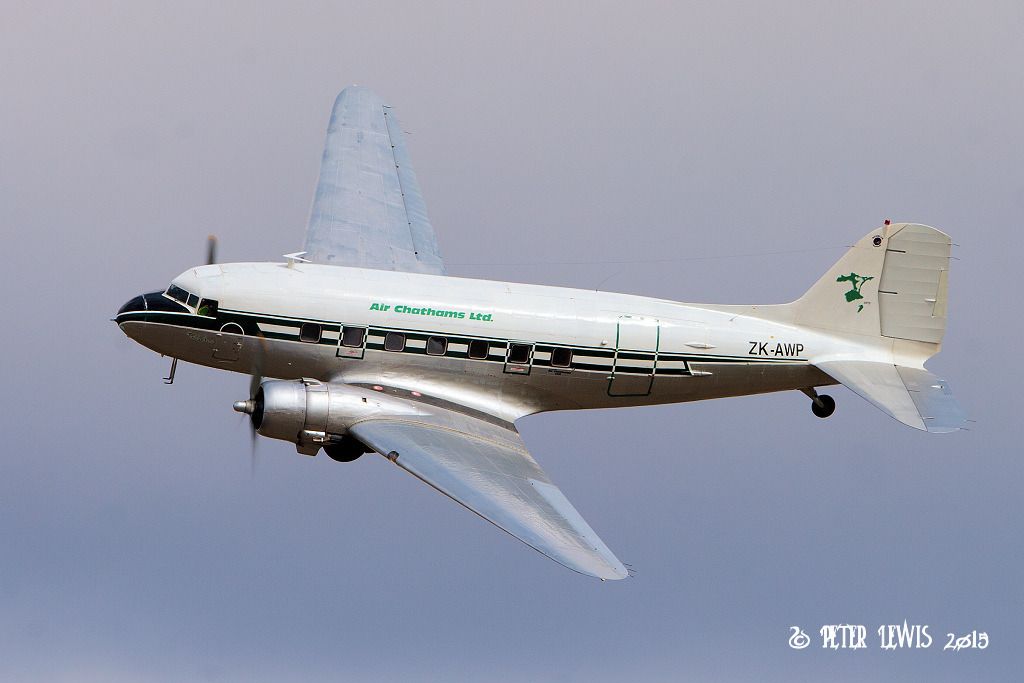 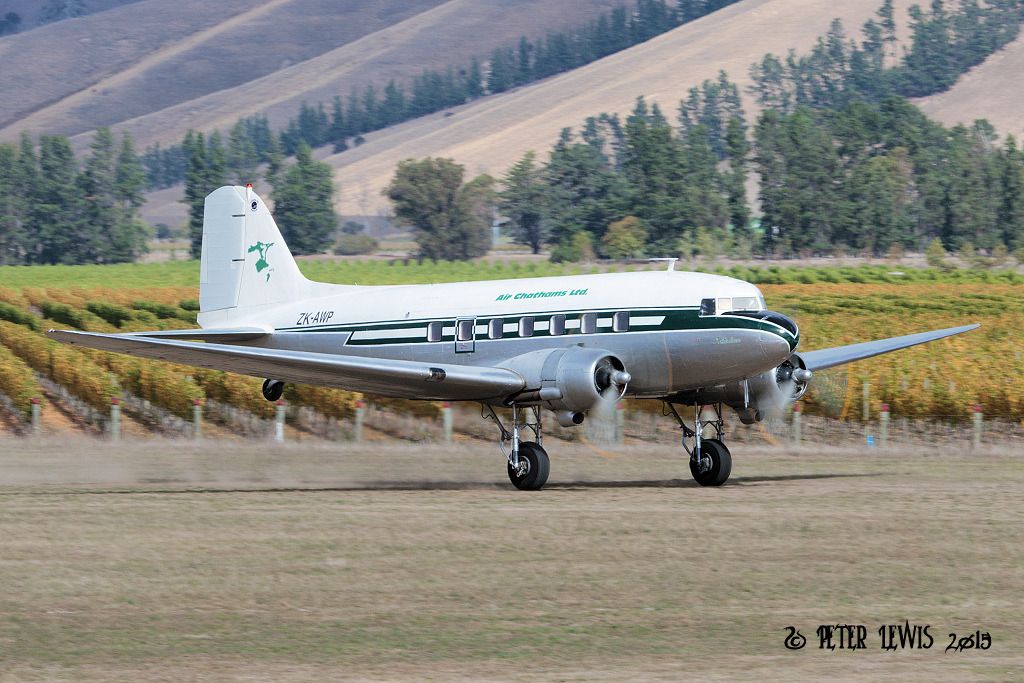 |
|
|
|
Post by Peter Lewis on Jun 1, 2015 17:49:41 GMT 12
The second active DC3 was the Flight 2000 example from Armore, ZK-DAK. Traditionally known as 'The Warbirds Dak". Although it now carries RNZAF colours, it actually spent the war years in service with the USAAF. When peace came, it migrated to Philippine Airlines as PI-C486 until moving to Australia in 1970 as VH-PNM. The final australian owner was the Mackay Air Museum in Queensland who reregistered it as VH-SBT in 1984. Resurrected, it arrived here in March 1987 and became ZK-DAK with the Warbirds DC-3 Syndicate (Inc.), Auckland. The aircraft has been operating in charter work throughout the country ever since. As well as taking part in the show, ZK-DAK earned its keep with joyriding customers throughout the event.   |
|
|
|
Post by Peter Lewis on Jun 2, 2015 9:28:59 GMT 12
The third aircraft was Douglas DC3C-S1C3G ZK-JGB. This started life as Bu4703, a Douglas R-4D for the US Navy. Following this service came years of civil operation in the US, South America, South Africa and Iceland. It eventually came to the UK in 2011 as N451ZS. Fitted out for passenger operations, its next adventure was to retrace the route taken by Jean Batten in her Percival Gull G-ADPR from the UK to New Zealand in October 1936. The DC3 departed from Lydd in the UK and took 90 hours 46 minutes flying time to reach Auckland on 16th November 2012. After a short tour around the country, the DC3 ended up in storage at Omaka in July 2013. Resurected earlier this year, it became ZK-JGB on 16Feb2015 with Airscapade Affairs Ltd., Te Anau. However, at the time of the show, the maintenance work had not been completed and the aircraft remained static. 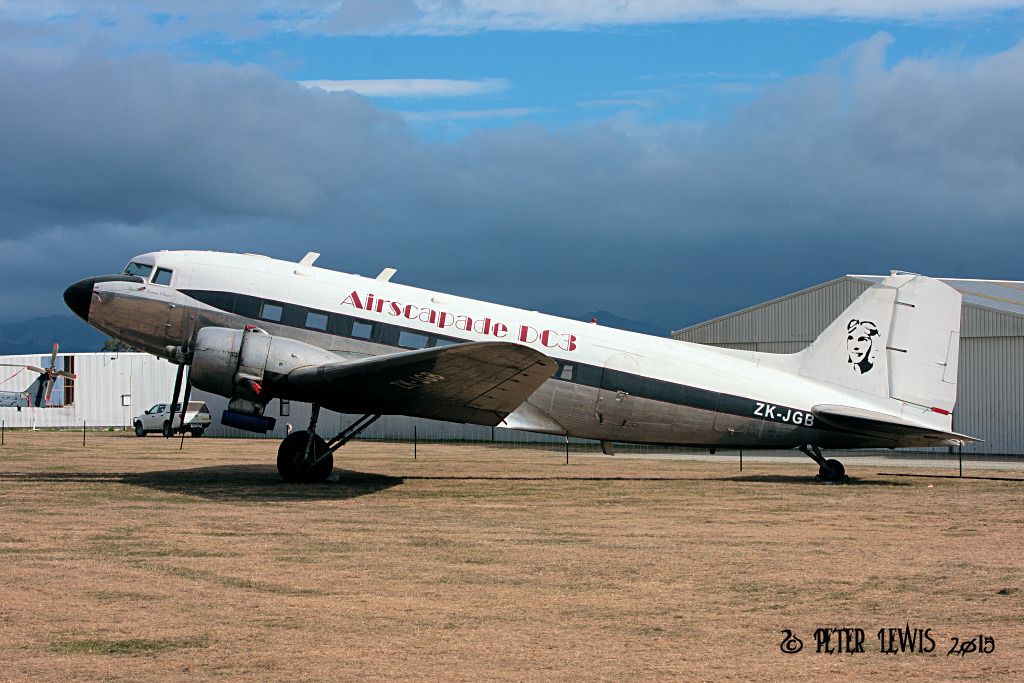 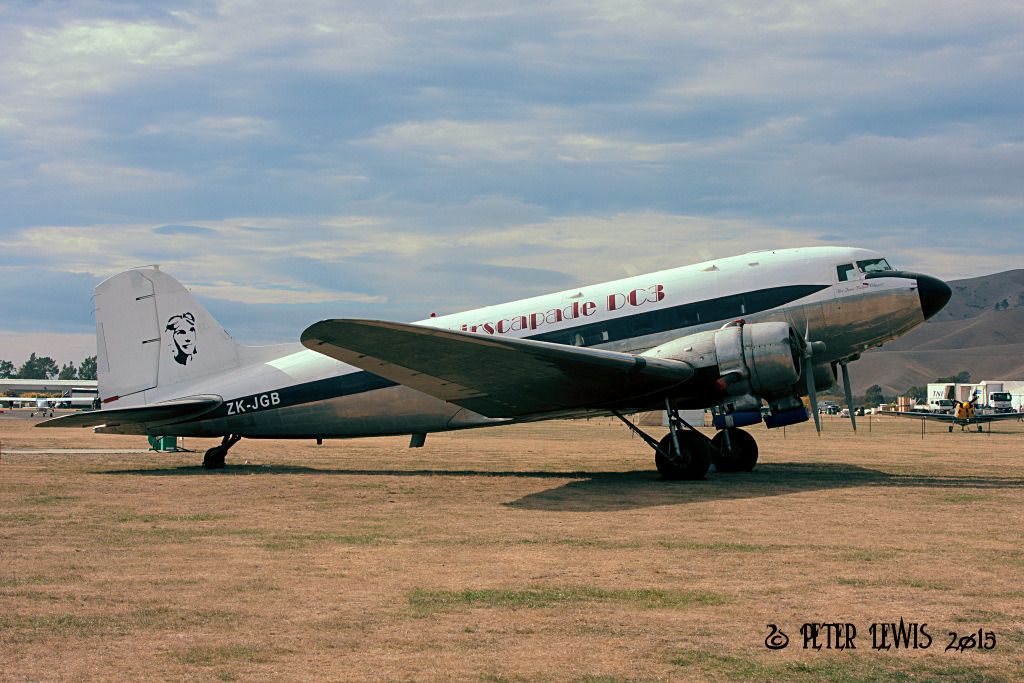 |
|



